On the downside, I have seldom taken these with a tripod (usually because of limits on luggage), relying instead on other less stable methods of keeping the shots properly aligned. The exercise also emphasised the need for care in the subjects that you use with these particular techniques
My first attempt – and one of the false starts referred to above - used these two shots of a wooden barn in Switzerland.
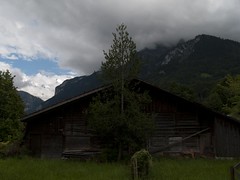
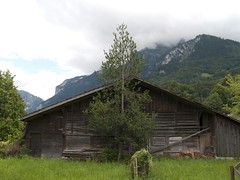
The two shots were taken at 17mm; f/11; 1/200 and 1/50 respectively and they are sufficiently close in alignment to allow an accurate overlay by making use of a small ‘nudge’ on the top layer. Unfortunately there is a small amount of motion blur in some of the vegetation in the lighter version which means we can never obtain a really high-quality print. However, for the exploration in this exercise the movement is not the issue.
Using the Eraser Tool 1
In this version I have used the eraser tool, but rather than go for a total erase I have reduced the opacity to 10% and worked over the sky area several times with a relatively large soft edged eraser– bringer more detail back in to the blown out areas of sky and blending them down to the darker areas.
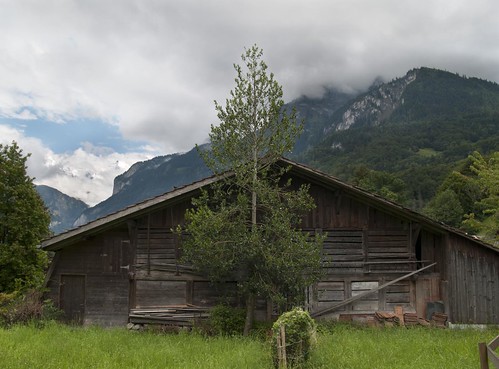
As the student notes observe, this does not give fine control of the area affected. On the other hand it does provide very good control over the level of improvement/replacement making it easy to obtain a natural looking result. So far, so good. Unfortunately by contrast the ‘select and delete’ method suffers from a number of problems.
Select and Delete 1
I could only obtain poor results with this technique.
- The new sky is much too dark and un-natural looking and cannot be selectively improved using this technique (although others could be employed)
- The soft edge of the clouds where they fall over the hills is difficult to select and feather to make a convincing blend
- Although selection is more accurate that a simple eraser the individual spaces between the leaves of the small tree in the foreground are difficult and very time consuming to select and result in an un-natural appearance.
2nd Attempt
Most of these difficulties are down to the choice of subject/image – so I repeated the exercise with an image with a much simpler skyline. The relatively smooth contours and lack of fine skyline detail in this image make selection much simpler.
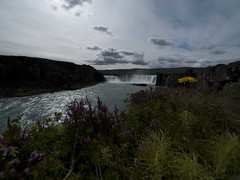

The two exposures are (EXPOSURES) respectively.
Eraser Tool 2
Again using a large soft-edged eraser it is relatively straightforward to restore detail to the sky in a relatively natural way. I have not restored all the detail in the brightest areas as I felt this was more consistent with a contre-jour shot such as this. Note that I used the same technique to reduce the specular highlights on the water and add detail to the waterfall as well.
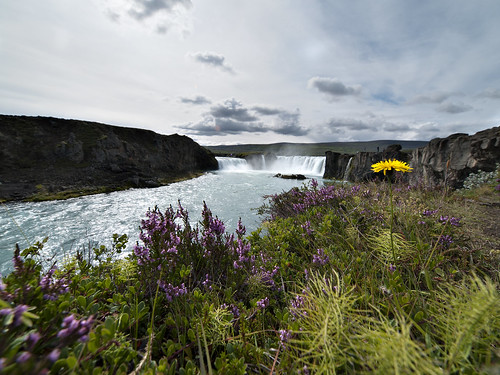
Select and Delete 2
The select and delete shot is also an attractive option. It was certainly more difficult to obtain a natural looking blend between the new sky and the original landscape but I am reasonably happy with this outcome. Note that I used the eraser brush technique to improve the waterfall and river, as previously – use of the delete technique is not effective here because of the exposure difference.

Adding a new sky
The image I chose for this also has a relatively simple skyline, but I ran in to the issue explored in the previous exercise – that is, I had to use personal judgement to some degree to select the skyline as the boundary between the snow field and the cloud was not always clear cut. The replacement sky was taken from an image which had sunlight from roughly the same direction.
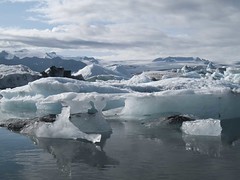
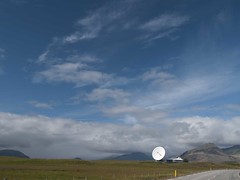
The end result is considerably more attractive than the original. I slightly increased the lightness of the blue sky by moving the white point down to 194 in levels, and also slightly reduced the ‘blueness’ using the colour variations tool to achieve a more natural effect.
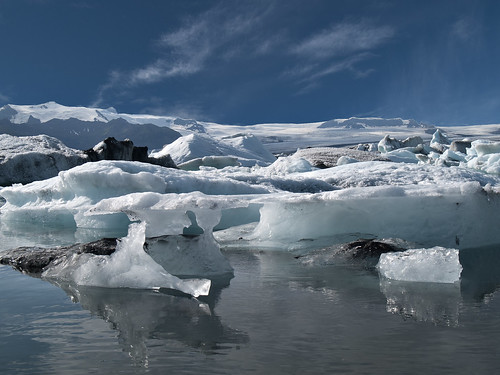
Conclusions
First the practical ones:
- The select and delete method is simple and effective but requires quite a bit more time to complete, and offers considerably less control over the final product when simply replacing one exposure with another.
- Either technique works more easily with less detailed skylines. Pictures where the cloud impinges on the landscape are best managed with the eraser tool technique.
- When replacing a sky, care is needed to obtain a reasonably natural looking edge as the opportunities for blending are much reduced.
- I see no issue with simply using these techniques to compensate for the dynamic range limitations of the sensor as in the first two examples.
- Some may feel that replacing a sky with a completely different one is ‘cheating’ – the scene never looked like that. Be that as it may the final version is much closer to my memory of that visit – and as this is a holiday photo for my own purposes there is no issue.
- For other uses I believe the general conclusions of my recent post still hold – provide there is no intent to deceive use of this technique is fine. For example – a website for Icelandic holidays could reasonably use this photo to illustrate the location, because days with bright blue skies do – regularly – occur here. In such a circumstance this is simply a way of overcoming the practical difficulties of reaching a relatively remote location at exactly the right time.
- On the other hand – when used to mislead – for example by adding a backdrop of distant mountains to the brochure photo of a hotel there are clearly some ethical issues to be addressed. As a working press officer I have been subjected to this treatment of our plants on a number of occasions – all of which resulted in phone-calls to the editor or picture desk.



No comments:
Post a Comment